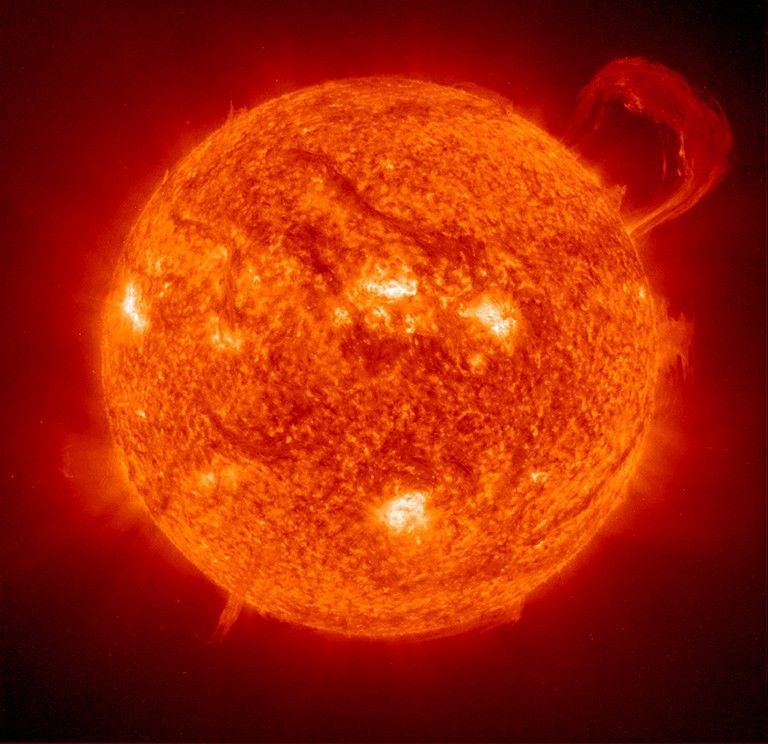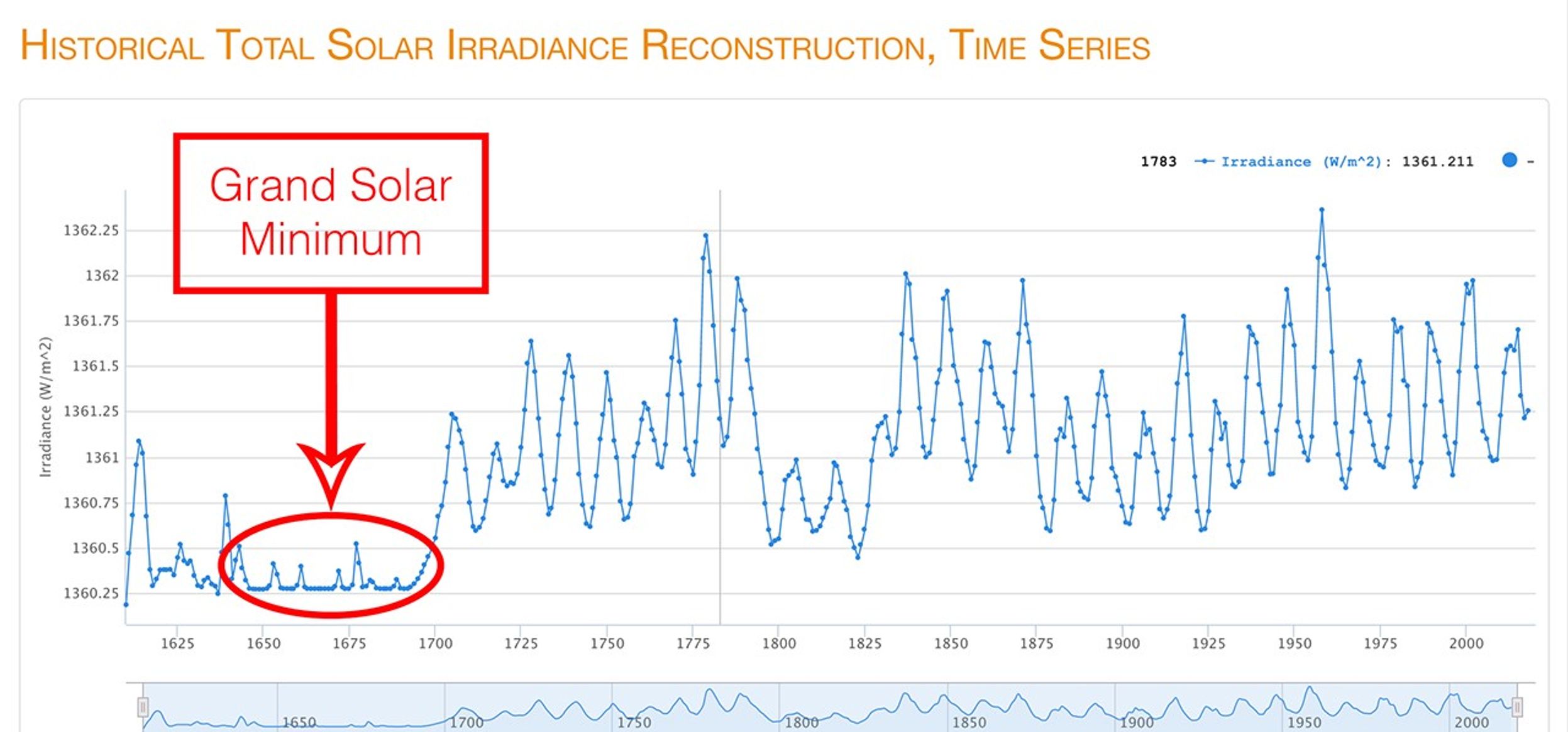"Pink elephant in the room" time: There is no impending “ice age” or "mini ice age" if there's a reduction in the Sun’s energy output in the next several decades.
Through its lifetime, the Sun naturally goes through changes in energy output. Some of these occur over a regular 11-year period of peak (many sunspots) and low activity (fewer sunspots), which are quite predictable.

The amount of solar energy that Earth receives has followed the Sun’s natural 11-year cycle of small ups and downs with no net increase since the 1950s. Over the same period, global temperature has risen markedly. It is therefore extremely unlikely that the Sun has caused the observed global temperature warming trend over the past half-century.
But every so often, the Sun becomes quieter for longer periods of time, experiencing much fewer sunspots and giving off less energy. This is called a "Grand Solar Minimum," and the last time this happened, it coincided with a period called the "Little Ice Age" (a period of extremely low solar activity from approximately AD 1650 to 1715 in the Northern Hemisphere, when a combination of cooling from volcanic aerosols and low solar activity produced lower surface temperatures).
Anomalous periods like a Grand Solar Minimum show that magnetic activity and energy output from the Sun can vary over decades, although the space-based observations of the last 35 years have seen little change from one cycle to the next in terms of total irradiance. Solar Cycle 24, which began in December 2008 and is likely to end in 2020, was smaller in magnitude than the previous two cycles.
On occasion, researchers have predicted that coming solar cycles may also exhibit extended periods of minimal activity. The models for such predictions, however, are still not as robust as models for our weather and are not considered conclusive.
But if such a Grand Solar Minimum occurred, how big of an effect might it have? In terms of climate forcing – a factor that could push the climate in a particular direction – solar scientists estimate it would be about -0.1 W/m2, the same impact of about three years of current carbon dioxide (CO2) concentration growth.
Thus, a new Grand Solar Minimum would only serve to offset a few years of warming caused by human activities.
What does this mean? The warming caused by the greenhouse gas emissions from the human burning of fossil fuels is six times greater than the possible decades-long cooling from a prolonged Grand Solar Minimum.
Even if a Grand Solar Minimum were to last a century, global temperatures would continue to warm. The reason for this is because more factors than just variations in the Sun’s output change global temperatures on Earth, the most dominant of those today is the warming coming from human-induced greenhouse gas emissions.
The Sun powers life on Earth; it helps keep the planet warm enough for us to survive. It also influences Earth’s climate: We know subtle changes in Earth’s orbit around the Sun are responsible for the comings and goings of the past ice ages. But the warming we’ve seen over the last few decades is too rapid to be linked to changes in Earth’s orbit, and too large to be caused by solar activity.
The Sun doesn’t always shine at the same level of brightness; it brightens and dims slightly, taking approximately 11 years to complete one solar cycle. During each cycle, the Sun undergoes various changes in its activity and appearance. Levels of solar radiation go up or down, as does the amount of material the Sun ejects into space and the size and number of sunspots and solar flares. These changes have a variety of effects in space, in Earth’s atmosphere and on Earth’s surface.
The current solar cycle, Solar Cycle 24, began in December 2008 and is less active than the previous two. It’s expected to end sometime in 2020. Scientists don’t yet know with confidence how strong the next solar cycle may be.
What Effect Do Solar Cycles Have on Earth’s Climate?
According to the United Nations’ Intergovernmental Panel on Climate Change (IPCC), the current scientific consensus is that long and short-term variations in solar activity play only a very small role in Earth’s climate. Warming from increased levels of human-produced greenhouse gases is actually many times stronger than any effects due to recent variations in solar activity.
For more than 40 years, satellites have observed the Sun's energy output, which has gone up or down by less than 0.1 percent during that period. Since 1750, the warming driven by greenhouse gases coming from the human burning of fossil fuels is over 50 times greater than the slight extra warming coming from the Sun itself over that same time interval.
Are We Headed for a ‘Grand Solar Minimum’? (And Will It Slow Down Global Warming?)
As mentioned, the Sun is currently experiencing a lower level of sunspot activity. Some scientists speculate that this may be the beginning of a Grand Solar Minimum — a decades-to-centuries-long period of low solar activity — while others say there is insufficient evidence to support that position. During a grand minimum, solar magnetism diminishes, sunspots appear infrequently and less ultraviolet radiation reaches Earth.
The largest recent event -- the “Maunder Minimum,” which lasted from 1645 and 1715 — overlapped with the “Little Ice Age” (13th to mid-19th century). While scientists continue to research whether an extended solar minimum could have contributed to cooling the climate, there is little evidence that the Maunder Minimum sparked the Little Ice Age, or at least not entirely by itself (notably, the Little Ice Age began before the Maunder Minimum). Current theories on what caused the Little Ice Age consider that a variety of events could have contributed, with natural fluctuations in ocean circulation, changes in land use by humans and cooling from a less active sun also playing roles; overall, cooling caused by volcanic aerosols likely played the title role.
Several studies in recent years have looked at the effects that another Grand Solar Minimum might have on global surface temperatures. These studies have suggested that while a grand minimum might cool the planet as much as 0.3 degrees C, this would, at best, slow down but not reverse human-caused global warming. There would be a small decline of energy reaching Earth; however, just three years of current carbon dioxide concentration growth would make up for it. In addition, the Grand Solar Minimum would be modest and temporary, with global temperatures quickly rebounding once the event concluded.
Moreover, even a prolonged Grand Solar Minimum or Maunder Minimum would only briefly and minimally offset human-caused warming.
More about solar cycles:




































